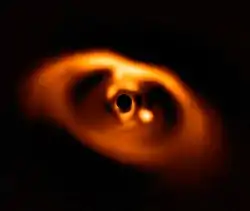Mega-Earth
A mega-Earth is a massive terrestrial exoplanet that is at least ten times the mass of Earth. Mega-Earths are substantially more massive than super-Earths (terrestrial and ocean planets with masses around 5–10 Earths). The term "mega-Earth" was coined in 2014, when Kepler-10c was revealed to be a Neptune-mass planet with a density considerably greater than that of Earth.[1][2] However, it has since been determined to be a typical volatile-rich planet.[3]

Examples
Kepler-10c was the first exoplanet to be classified as a mega-Earth. At the time of its discovery, it was believed to have a mass around 17 times that of Earth (M⊕) and a radius around 2.3 times Earth's (R⊕), giving it a high density that implied a mainly rocky composition. However, several follow-up radial velocity studies produced different results for Kepler-10c's mass, all much below the original 17 M⊕ estimate. In 2017, a more careful analysis using data from multiple different telescopes and spectrographs found that Kepler-10c is more likely around 7.4 M⊕, making it a typical volatile-rich mini-Neptune and not a mega-Earth.[4][3]
K2-56b, also designated BD+20594b, is a much more likely mega-Earth,[5] with about 16 M⊕ and 2.2 R⊕. At the time of its discovery in 2016, it had the highest chance of being rocky for a planet its size, with a posterior probability that it is dense enough to be terrestrial at about 0.43. For comparison, at the time the corresponding probability for Kepler-10c was calculated as 0.1, and as 0.002 for Kepler-131b.[6]
Kepler-145b is one of the most massive planets classified as mega-Earths, with a mass of 37.1 M⊕ and a radius of 2.65 R⊕, so large that it could belong to a sub-category of mega-Earths known as supermassive terrestrial planets (SMTP). It likely has an Earth-like composition of rock and iron without any volatiles. A similar mega-Earth, K2-66b, has a mass of about 21.3 M⊕ and a radius of about 2.49 R⊕, and orbits a subgiant star. Its composition appears to be mainly rock with a small iron core and a relatively thin steam atmosphere.[7]
Kepler-277b and Kepler-277c are a pair of planets orbiting the same star, both thought to be mega-Earths with masses of about 87.4 M⊕ and 64.2 M⊕, and radii of about 2.92 R⊕ and 3.36 R⊕, respectively.[8]
References
- Sasselov, Dimitar (2 June 2014) Exoplanets: From Exhilarating to Exasperating, 22:59, Kepler-10c: The "Mega-Earth", YouTube
- "Astronomers Find a New Type of Planet: The "Mega-Earth"2014-14". www.cfa.harvard.edu/.
- The mass of Kepler-10c revisited: upping the radial velocities game, Leonardo dos Santos, 7 August 2017, astrobites
- Pinning down the mass of Kepler-10c: the importance of sampling and model comparison, Vinesh Rajpaul, Lars A. Buchhave, Suzanne Aigrain, 19 July 2017
- Futó, P (2017). BD+20594B: A Mega-Earth Detected in the C4 field of the Kepler K2 mission (PDF). 48th Lunar and Planetary Science Conference. Retrieved 6 September 2020.
- Discovery and Validation of a High-Density sub-Neptune from the K2 Mission, Néstor Espinoza, Rafael Brahm, Andrés Jordán, James S. Jenkins, Felipe Rojas, Paula Jofré, Thomas Mädler, Markus Rabus, Julio Chanamé, Blake Pantoja, Maritza G. Soto, Katie M. Morzinski, Jared R. Males, Kimberly Ward-Duong, Laird M. Close, Submitted on 28 January 2016, last revised 14 July 2016
- Futó, P (2018). Kepler-145b and K2-66b: A Kepler- and a K2-Mega-Earth with Different Compositional Characteristics (PDF). 49th Lunar and Planetary Science Conference. Retrieved 6 September 2020.
- Futó, P (2020). Kepler-277 b: A Supermassive Terrestrial Exoplanet in the Kepler-277 Planetary System (PDF). 51st Lunar and Planetary Science Conference. Retrieved 6 September 2020.
Works cited
- Futó, P; Gucsik, A (2018). Basic Mineralogical Models for Silicate- and Carbon-Rich Mega-Earths Considering Compositional and Geophysical Constraints (PDF). 49th Lunar and Planetary Science Conference. Retrieved 6 September 2020.
